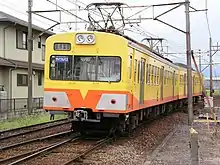 A Sangi Line 801 series train | |
| Overview | |
|---|---|
| Main region(s) | Mie Prefecture, Japan |
| Dates of operation | 1928– |
| Other | |
| Website | Official website (in Japanese) |
Sangi Railway Co., Ltd. (三岐鉄道株式会社, Sangi Tetsudō) is a private railway company in Mie Prefecture, Japan, which also operates bus lines. The company was founded in 1928 and its initial line, the Sangi Line, originally functioned as a freight line transporting cement, but in recent years it became important as a commuter railway line for Yokkaichi. The Hokusei Line was transferred from Kintetsu ownership in 2003, when Kintetsu abandoned the line. Whereas the Sangi Line has a track gauge of 1,067 mm (3 ft 6 in), the Hokusei Line is one of only a few 762 mm (2 ft 6 in) narrow gauge lines remaining in the country.
History
The Sangi Line was opened by Onoda Cement in 1931 as a freight-only line to service its cement plant at Nishi-Fujiwara. Passenger services were introduced in 1952, and in 1954, the line was electrified at 1,500 V DC, and the company purchased an electric locomotive from JNR to haul its cement trains. CTC signalling was commissioned on the line in 1974.
Rolling stock
Sangi Line
EMUs
- 801 series - Former Seibu 701 series trains acquired in 1989
- 101 series - Former Seibu 401 series trains acquired in 1990
- 851 series - Former Seibu 701 series trains acquired in 1995
- 751 series 3-car EMUs - Former Seibu 101 series trains acquired in 2009[1]
 801 series
801 series 101 series
101 series 751 series
751 series
Electric locomotives
- Class ED45: Since 1954 (includes former Tobu Railway locomotives)
- Class ED301: Former Nankai Class ED5201 acquired in 1984
- Class DeKi 200: Former Chichibu Railway Class DeKi 200 acquired in July 2000 and withdrawn in March 2011[2]
 ED45 class ED45 1
ED45 class ED45 1 DeKi 203
DeKi 203
Hokusei Line
EMUs
- 130 series - Built in 1954
- 200 series - Built in 1959
- 140 series - Built in 1960
- 270 series - Built in 1977
 Hokusei Line 270 series train
Hokusei Line 270 series train
See also
References
This article incorporates material from the corresponding article in the Japanese Wikipedia.